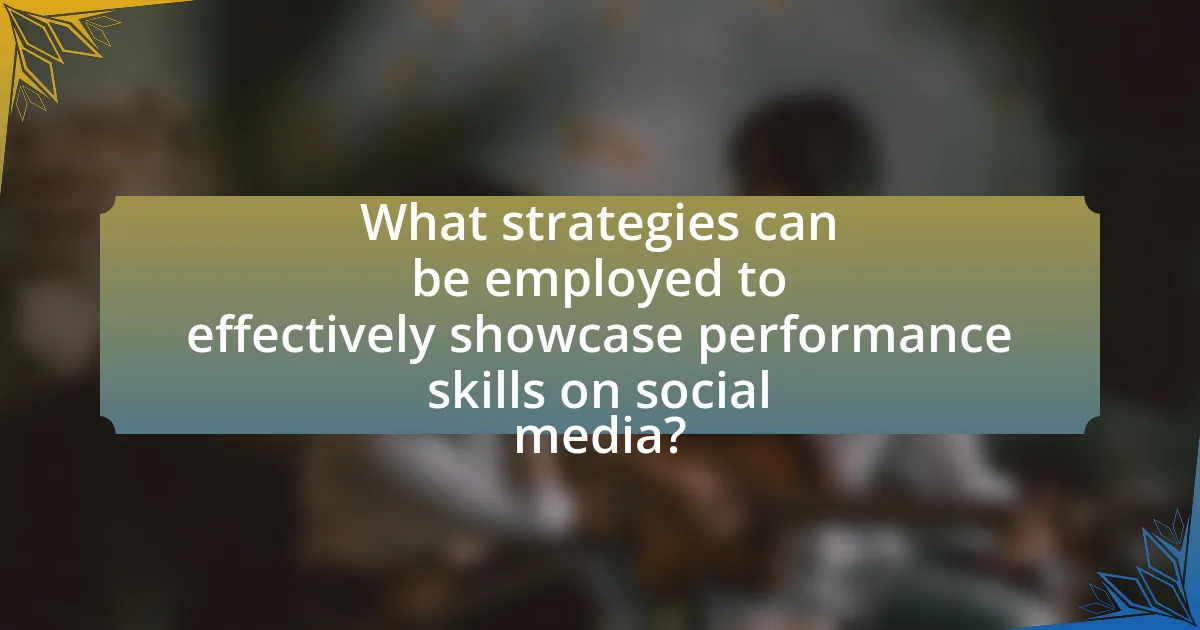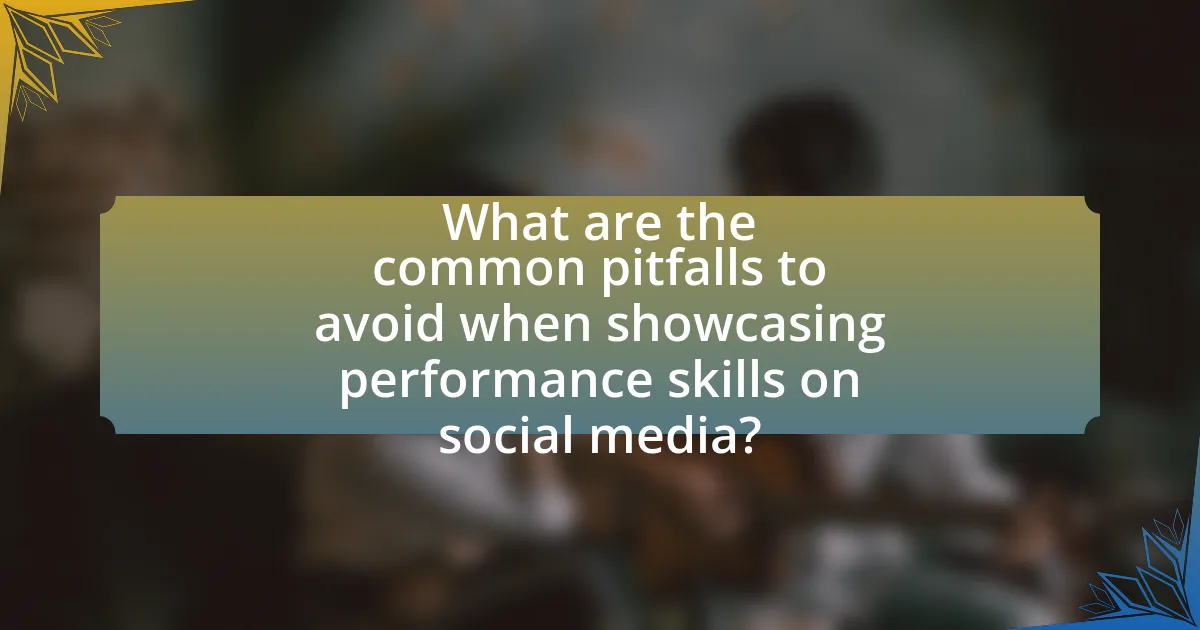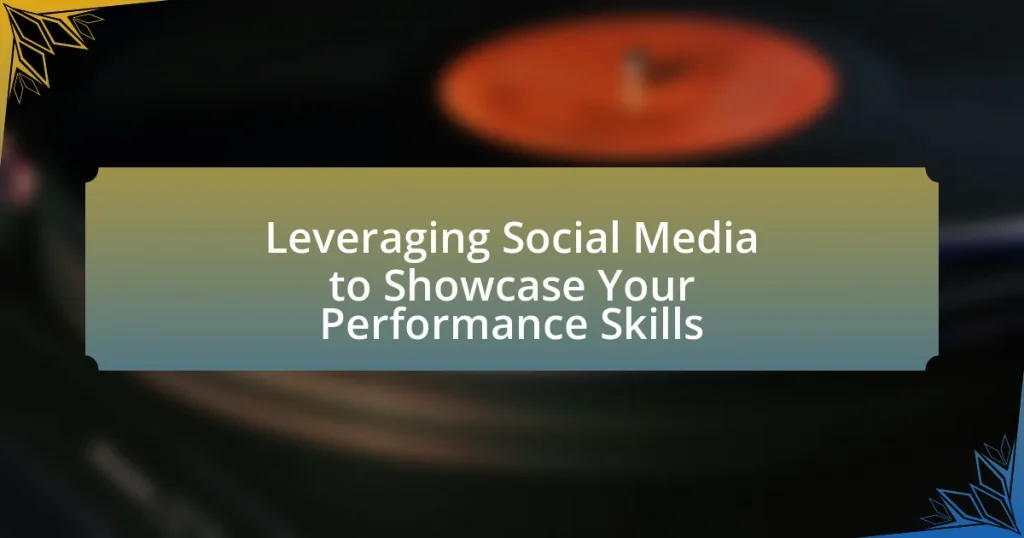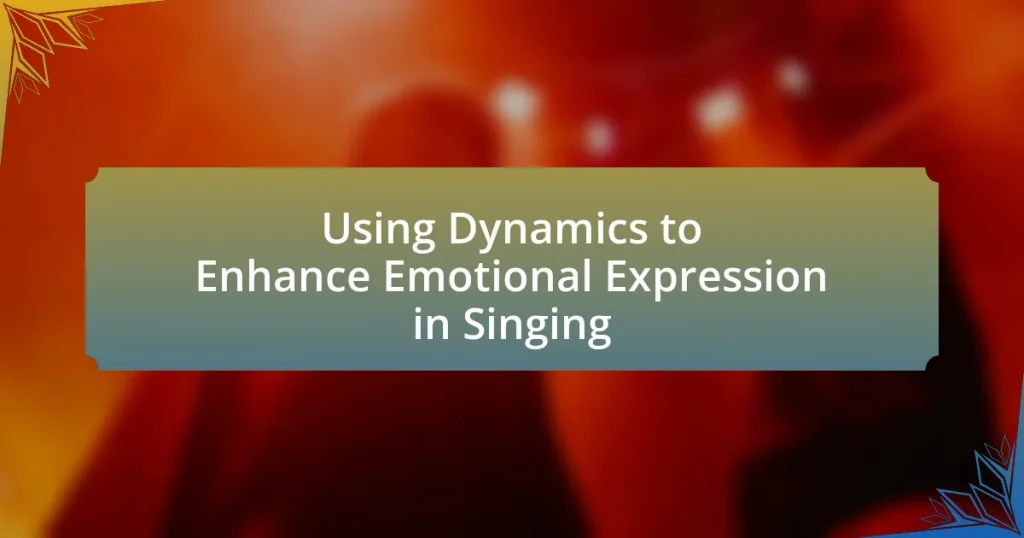Leveraging social media to showcase performance skills involves using platforms such as Instagram, TikTok, and YouTube to display talents and engage with a broader audience. This article explores how social media enhances visibility for various performance skills, including acting, dancing, and music, by providing tailored features for content sharing and audience interaction. It highlights the importance of audience engagement, effective content strategies, and the potential career benefits of a strong online presence, while also addressing common pitfalls performers should avoid. Key metrics for measuring success and best practices for maintaining authenticity in content promotion are also discussed.

What does it mean to leverage social media for showcasing performance skills?
Leveraging social media for showcasing performance skills means utilizing platforms like Instagram, TikTok, and YouTube to display and promote one’s talents in a public forum. This approach allows individuals to reach a wider audience, engage with followers, and receive immediate feedback on their performances. For instance, a musician can share live performances or behind-the-scenes content, while dancers can post choreography videos, thus enhancing their visibility and potentially attracting opportunities in their field. Social media’s interactive nature fosters community engagement, which can lead to collaborations and increased recognition in the industry.
How can social media platforms enhance visibility for performance skills?
Social media platforms enhance visibility for performance skills by providing a vast audience reach and enabling content sharing. These platforms allow performers to showcase their talents through videos, live streams, and posts, which can be easily shared and engaged with by users. For instance, platforms like Instagram and TikTok have algorithms that promote engaging content, increasing the likelihood of reaching new audiences. According to a study by the Pew Research Center, 69% of adults in the U.S. use social media, indicating a significant potential audience for performers. Additionally, social media facilitates networking opportunities with other artists and industry professionals, further amplifying visibility.
What types of performance skills can be showcased on social media?
Various performance skills can be showcased on social media, including acting, dancing, singing, musical instrument playing, public speaking, and comedy. These skills can be effectively demonstrated through video clips, live streams, and engaging posts that highlight talent and creativity. For instance, platforms like Instagram and TikTok allow users to share short performances, while YouTube enables longer, more detailed showcases. The popularity of these platforms has led to a significant increase in visibility for performers, with statistics showing that 54% of consumers want to see more video content from brands and creators, indicating a strong audience engagement with performance skills online.
How do different platforms cater to various performance skills?
Different platforms cater to various performance skills by providing tailored features that enhance user engagement and showcase specific talents. For instance, Instagram emphasizes visual content, making it ideal for performers like dancers and visual artists to share short clips or images that highlight their skills. TikTok, with its short-form video format, allows users to create engaging, creative performances that can go viral, particularly benefiting musicians and comedians. YouTube supports longer, more detailed content, enabling performers to showcase their skills through tutorials, live performances, or in-depth storytelling. Each platform’s unique algorithms and audience demographics further influence how performance skills are presented and received, ensuring that performers can effectively reach their target audience.
Why is showcasing performance skills on social media important?
Showcasing performance skills on social media is important because it enhances visibility and engagement with a broader audience. By sharing performance skills online, individuals can attract potential employers, collaborators, and fans, thereby expanding their professional network. According to a study by the Pew Research Center, 69% of adults in the U.S. use social media, making it a vital platform for reaching diverse demographics. Furthermore, showcasing skills can lead to increased opportunities, as 85% of jobs are filled through networking, highlighting the significance of an online presence in career advancement.
What are the potential career benefits of social media exposure?
Social media exposure can significantly enhance career opportunities by increasing visibility and networking potential. Professionals who actively engage on platforms like LinkedIn, Instagram, or Twitter can showcase their skills, achievements, and projects to a broader audience, which can lead to job offers, collaborations, and industry recognition. According to a survey by Jobvite, 92% of recruiters use social media to find candidates, highlighting the importance of a strong online presence in attracting career opportunities. Additionally, social media allows individuals to connect with industry leaders and peers, fostering relationships that can lead to mentorship and career advancement.
How does social media engagement impact audience reach?
Social media engagement significantly enhances audience reach by increasing visibility and interaction with content. When users actively engage through likes, shares, and comments, algorithms on platforms like Facebook and Instagram prioritize that content, leading to greater exposure to a wider audience. For instance, a study by Hootsuite found that posts with higher engagement rates can reach up to 50% more users than those with minimal interaction. This amplification effect allows creators to connect with potential followers and fans, ultimately expanding their audience base.

What strategies can be employed to effectively showcase performance skills on social media?
To effectively showcase performance skills on social media, individuals should utilize high-quality video content, engage with their audience, and leverage platform-specific features. High-quality video content captures attention and demonstrates skills clearly, as studies show that videos generate 1200% more shares than text and images combined. Engaging with the audience through comments, live sessions, and Q&A fosters community and encourages interaction, which can increase visibility and follower engagement. Additionally, using platform-specific features, such as Instagram Stories or TikTok challenges, can enhance reach and showcase creativity, as these features are designed to promote user engagement and virality.
How can content creation be optimized for performance showcases?
Content creation can be optimized for performance showcases by focusing on high-quality visuals, engaging storytelling, and strategic audience targeting. High-quality visuals, such as professional video production and well-composed images, enhance viewer engagement and retention, as studies show that content with compelling visuals receives 94% more views than text-only content. Engaging storytelling captures the audience’s attention and fosters emotional connections, which can lead to increased shares and interactions. Additionally, strategic audience targeting ensures that the content reaches the right demographics, maximizing its impact; for instance, using analytics tools can help identify the most responsive audience segments, leading to a 30% increase in engagement rates.
What types of content resonate best with audiences?
Engaging and visually appealing content types resonate best with audiences, particularly videos, infographics, and user-generated content. Research indicates that video content generates 1200% more shares than text and images combined, highlighting its effectiveness in capturing audience attention. Additionally, infographics are shared three times more than other content types, making them a powerful tool for conveying complex information quickly. User-generated content fosters community engagement and trust, as 79% of consumers say user-generated content highly impacts their purchasing decisions. These statistics demonstrate that audiences prefer content that is visually stimulating, easily digestible, and fosters interaction.
How can storytelling enhance the presentation of performance skills?
Storytelling enhances the presentation of performance skills by creating an emotional connection with the audience, which increases engagement and retention. When performers incorporate narratives into their presentations, they can illustrate their skills through relatable experiences, making the performance more memorable. Research indicates that stories activate multiple areas of the brain, leading to improved understanding and empathy among viewers. For instance, a study by Paul Zak found that storytelling can increase oxytocin levels, which fosters trust and connection, thereby enhancing the overall impact of the performance.
What role does audience engagement play in showcasing performance skills?
Audience engagement is crucial in showcasing performance skills as it enhances visibility and fosters a connection between the performer and the audience. Engaged audiences are more likely to share content, provide feedback, and participate in discussions, which amplifies the reach of the performance. For instance, a study by the Pew Research Center found that 72% of social media users have shared content related to performances, indicating that audience interaction can significantly increase exposure. This interaction not only validates the performer’s skills but also creates a community around their work, leading to greater opportunities for collaboration and growth in their career.
How can performers interact with their audience on social media?
Performers can interact with their audience on social media by engaging in real-time conversations, sharing behind-the-scenes content, and responding to comments and messages. This direct engagement fosters a sense of community and connection, which is crucial for building a loyal fan base. For instance, live streaming performances or Q&A sessions allows performers to receive immediate feedback and create a more personal experience for their audience. Additionally, utilizing polls and interactive stories can encourage audience participation, making followers feel valued and involved in the performer’s journey. Research indicates that 70% of consumers feel more connected to brands when they engage with them on social media, highlighting the importance of interaction in building relationships.
What techniques can be used to build a loyal following?
To build a loyal following, consistently engage with your audience through authentic interactions and valuable content. Engaging with followers by responding to comments, asking for feedback, and creating polls fosters a sense of community. Additionally, providing high-quality, relevant content that showcases your performance skills can attract and retain followers. Research indicates that brands that actively engage with their audience see a 20% increase in customer loyalty (source: Sprout Social). By combining authentic engagement with valuable content, you can effectively cultivate a dedicated following.

What are the common pitfalls to avoid when showcasing performance skills on social media?
Common pitfalls to avoid when showcasing performance skills on social media include oversharing content, neglecting audience engagement, and failing to maintain a consistent brand image. Oversharing can overwhelm followers and dilute the impact of key performances, as studies show that audiences prefer quality over quantity in content. Neglecting audience engagement can lead to decreased follower loyalty; research indicates that brands that actively engage with their audience see a 20-40% increase in customer satisfaction. Lastly, inconsistency in branding can confuse followers and weaken recognition; a survey by Lucidpress found that consistent branding can increase revenue by up to 23%.
What mistakes do performers often make on social media?
Performers often make the mistake of not engaging with their audience on social media. This lack of interaction can lead to diminished follower loyalty and reduced visibility, as platforms prioritize content that generates engagement. Additionally, performers frequently post inconsistent content, which can confuse their audience and dilute their brand identity. Research indicates that brands that maintain a consistent posting schedule see 67% more engagement than those that do not. Another common error is neglecting to analyze performance metrics, which can hinder their ability to refine their strategy based on what resonates with their audience.
How can oversharing negatively impact a performer’s image?
Oversharing can negatively impact a performer’s image by leading to a loss of professionalism and credibility. When performers disclose excessive personal information or controversial opinions, they risk alienating their audience and damaging their brand. For instance, a study by the Pew Research Center found that 70% of social media users have unfollowed someone due to oversharing, indicating that audiences prefer boundaries in personal and professional contexts. This erosion of audience trust can result in decreased engagement and opportunities, ultimately harming a performer’s career.
What are the risks of neglecting audience feedback?
Neglecting audience feedback poses significant risks, including misalignment with audience preferences, decreased engagement, and potential reputational damage. When creators ignore feedback, they may produce content that does not resonate with their audience, leading to lower interaction rates; for instance, a study by the Content Marketing Institute found that 70% of consumers prefer personalized content, which is often informed by audience feedback. Additionally, failing to address audience concerns can result in negative perceptions and loss of trust, as evidenced by brands that faced backlash for not responding to customer complaints on social media. Ultimately, neglecting audience feedback can hinder growth and diminish the effectiveness of performance skills showcased online.
How can performers measure the success of their social media efforts?
Performers can measure the success of their social media efforts by analyzing key performance indicators (KPIs) such as engagement rates, follower growth, and conversion metrics. Engagement rates, which include likes, shares, comments, and overall interaction with posts, provide insight into how well the content resonates with the audience. For instance, a study by Sprout Social found that posts with higher engagement rates typically lead to increased brand awareness and loyalty. Follower growth indicates the expanding reach of the performer’s brand, while conversion metrics, such as ticket sales or merchandise purchases linked to social media campaigns, directly reflect the effectiveness of promotional efforts. By regularly tracking these metrics, performers can gain a clear understanding of their social media impact and adjust their strategies accordingly.
What metrics should be tracked to evaluate performance showcases?
To evaluate performance showcases, key metrics to track include engagement rate, reach, impressions, audience growth, and conversion rate. Engagement rate measures interactions (likes, comments, shares) relative to total views, indicating how well the content resonates with the audience. Reach quantifies the total number of unique users who see the content, while impressions count how many times the content is displayed, regardless of clicks. Audience growth tracks the increase in followers or subscribers over time, reflecting the effectiveness of the showcase in attracting new viewers. Conversion rate assesses the percentage of viewers who take a desired action, such as signing up for a newsletter or purchasing a ticket, demonstrating the showcase’s impact on audience behavior. These metrics provide a comprehensive view of performance effectiveness on social media platforms.
How can feedback be utilized to improve future content?
Feedback can be utilized to improve future content by systematically analyzing audience responses and preferences. By collecting data through comments, likes, shares, and direct messages, creators can identify which aspects of their content resonate most with viewers. For instance, a study by the Content Marketing Institute found that 70% of marketers use audience feedback to refine their strategies, indicating its effectiveness in content optimization. This data-driven approach allows creators to adjust their themes, formats, and delivery methods, ensuring that future content aligns more closely with audience expectations and enhances engagement.
What are some best practices for leveraging social media to showcase performance skills?
To effectively leverage social media for showcasing performance skills, individuals should consistently create high-quality content that highlights their abilities. This includes posting videos of performances, engaging with followers through live sessions, and utilizing platforms like Instagram and TikTok, which favor visual content. Research indicates that 54% of consumers prefer to see video content from brands they support, emphasizing the importance of video in showcasing skills. Additionally, using relevant hashtags can increase visibility, as posts with at least one hashtag receive 12.6% more engagement than those without. Engaging with the audience through comments and direct messages fosters community and encourages sharing, further amplifying reach.
How can consistency in posting enhance visibility?
Consistency in posting enhances visibility by increasing audience engagement and improving algorithmic favorability on social media platforms. Regularly sharing content keeps the audience informed and connected, leading to higher interaction rates, which can boost the content’s reach. For instance, platforms like Instagram and Facebook prioritize accounts that post consistently, as this behavior signals active engagement, resulting in more frequent appearances in followers’ feeds. Research indicates that brands that post consistently can see up to 50% more engagement compared to those that post sporadically, demonstrating the direct correlation between posting frequency and visibility.
What tips can help maintain authenticity while promoting performance skills?
To maintain authenticity while promoting performance skills, individuals should focus on sharing genuine experiences and insights related to their craft. Authenticity is achieved by being transparent about one’s journey, including both successes and challenges, which resonates with audiences and builds trust. For instance, artists who share behind-the-scenes content or personal stories about their creative process often engage their followers more effectively, as evidenced by studies showing that audiences prefer relatable and honest content over polished, overly curated posts. This approach not only showcases performance skills but also fosters a deeper connection with the audience, enhancing overall engagement and loyalty.















